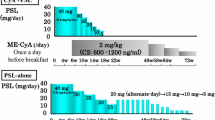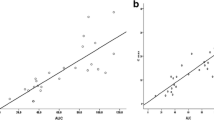Abstract
Background/Aims
The present study evaluated the clinical efficacy and pharmacokinetics of microemulsion cyclosporine A (ME-CyA) with modification from postprandial to preprandial administration in adult patients with refractory nephrotic syndrome.
Methods
We investigated 19 patients with refractory nephrotic syndrome who had been switched from the postprandial administration of ME-CyA to preprandial administration. The pharmacokinetics of ME-CyA were also evaluated before and 6 months after switching from postprandial to preprandial administration by serial measurement of the blood CyA concentration in 10 patients.
Results
This study showed that 16 of 19 patients (84%) displayed an improvement in their clinical condition or continued to maintain remission after switching from post- to preprandial administration. In particular among 14 patients with minimal change nephrotic syndrome (MCNS) in this study, 13 patients maintained or achieved remission under preprandial ME-CyA administration. Only three of 10 patients with postprandial administration showed a peak concentration> 500 ng/ml within 1–2 h after administration, while with preprandial administration, nine of 10 patients showed this good absorption profiles. This effectiveness of preprandial administration seems to be dependent on the improved pharmacokinetics with the increase of area under the curve from 0–4 h (AUC0–4) and peak concentration. There were no statistical differences in the mean daily doses of ME-CyA between both administration periods. No ME-CyA-induced nephrotoxicity or other harmful events were encountered throughout the study.
Conclusion
The preprandial administration of ME-CyA results in a good pharmacokinetic profile and is useful for management of refractory nephrotic syndrome in adults, particularly in patients with MCNS.




Similar content being viewed by others
References
Tanaka H, Nakahata T, Ito E. Single-dose daily administration of cyclosporin A for relapsing nephrotic syndrome. Pediatr Nephrol. 2004;19:1055–8.
Ghiggeri GM, Catarsi P, Scolari F, Caridi G, Bertelli R, Carrea A, et al. Cyclosporine in patients with steroid-resistant nephrotic syndrome: an open-label, nonrandomized, retrospective study. Clin Ther. 2004;26:1411–8.
Kusaba T, Konno Y, Hatta S, Fujino T, Yasuda T, Miura H, et al. More stable and reliable pharmacokinetics with preprandial administration of cyclosporine compared with postprandial administration in patients with refractory nephrotic syndrome. Pharmacotherapy. 2005;25:52–8.
Mraz W, Muller C, Molnar B, Knedel M. Analysis of cyclosporin A (CsA) concentrations by fluorescence polarization immunoassay (FPIA): comparison with radio immunoassay (RIA) and liquid chromatography (HPLC). Transplant Proc. 1989;21:885–7.
Dalere GM, Lum BL, Cooney GF, Wong-Chin M. Comparison of three methods for cyclosporine area under the curve monitoring calculations. Ther Drug Monit. 1995;17:305–7.
Cattran DC, Appel GB, Hebert LA, Hunsicker LG, Pohl MA, Hoy WE, et al. Cyclosporine in patients with steroid-resistant membranous nephropathy: a randomized trial. Kidney Int. 2001;59:1484–90.
Filler G. How should microemulsified Cyclosporine A (Neoral) therapy in patients with nephrotic syndrome be monitored? Nephrol Dial Transplant. 2005;20:1032–4.
Kung L, Batiuk TD, Palomo-Pinon S, Noujaim J, Helms LM, Halloran PF. Tissue distribution of calcineurin and its sensitivity to inhibition by cyclosporine. Am J Transplant. 2001;1:325–33.
Halloran PF, Helms LM, Kung L, Noujaim J. The temporal profile of calcineurin inhibition by cyclosporine in vivo. Transplantation. 1999;68:1356–61.
Rainiene T, Papinigiene L, Laurinavicius A. [Nephrotoxicity of cyclosporin A after kidney transplantation]. Medicina (Kaunas). 2003;39(Suppl 1):161–5.
Tarantino A, Passerini P, Campise M, Bonizzoni E, Ceccarini F, Montagnino G, et al. Is cyclosporine in renal-transplant recipients more effective when given twice a day than in a single daily dose? Transplantation. 2004;78:675–80.
Author information
Authors and Affiliations
Corresponding author
About this article
Cite this article
Shirai, S., Yasuda, T., Tsuchida, H. et al. Preprandial microemulsion cyclosporine administration is effective for patients with refractory nephrotic syndrome. Clin Exp Nephrol 13, 123–129 (2009). https://doi.org/10.1007/s10157-008-0112-z
Received:
Accepted:
Published:
Issue Date:
DOI: https://doi.org/10.1007/s10157-008-0112-z




